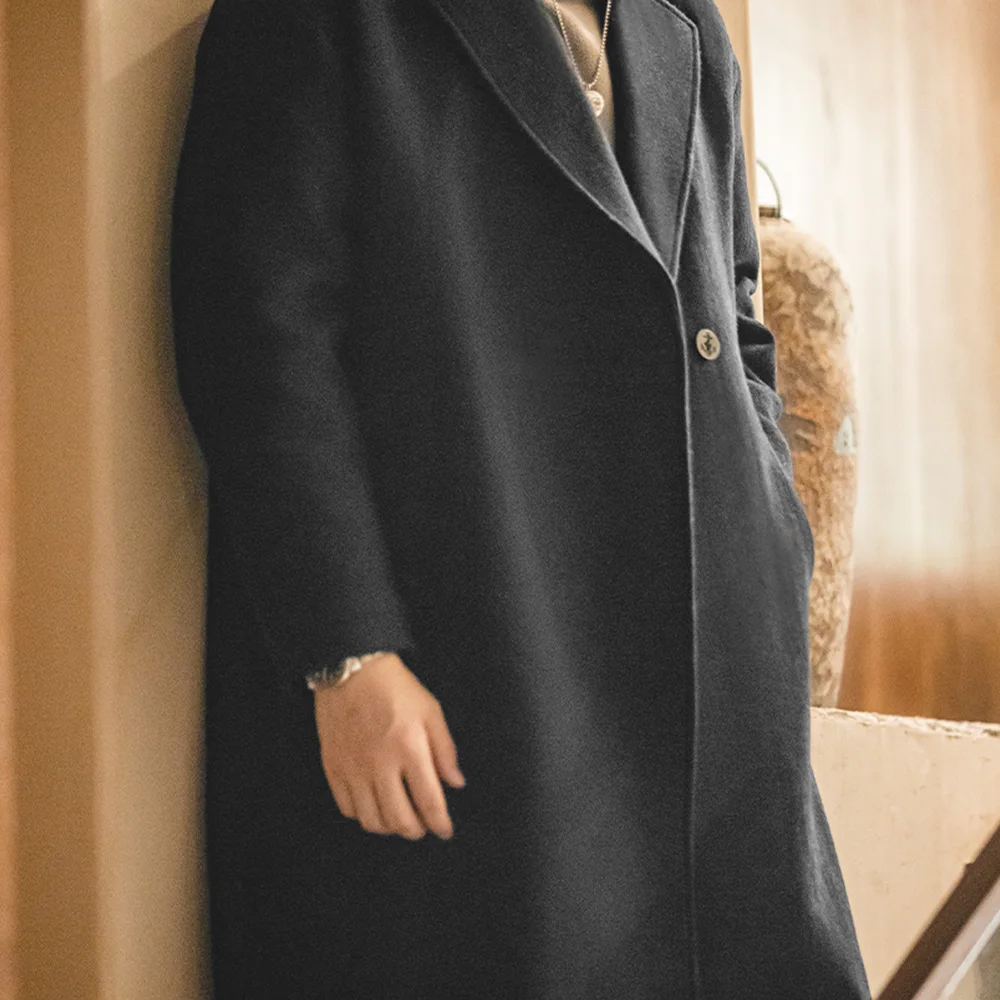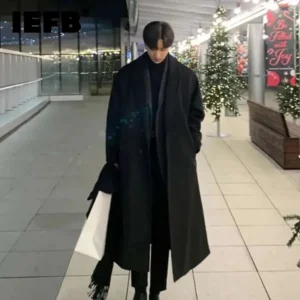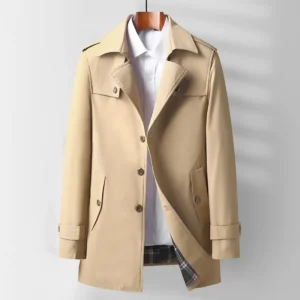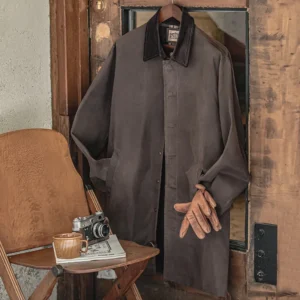Why a Formal Dress Coat is an Essential Wardrobe Investment
A formal dress coat represents more than just an outer layer – it’s the finishing touch that completes your elegant ensemble. This distinguished garment serves as the first element others notice, creating that crucial initial impression before you’ve even spoken a word.
Quality formal outerwear offers several distinct advantages:
- It enhances the appearance of what you’re wearing underneath, elevating even simple formal attire
- It provides necessary protection against the elements without compromising on sophistication
- It communicates attention to detail and sartorial awareness
- It serves multiple formal occasions, from business meetings to evening galas
- It frames your entire look, creating a polished silhouette
The importance of proper choosing the right coat length cannot be overstated. Throughout history, well-dressed men from Winston Churchill to Cary Grant understood that a precisely fitted coat transforms a good outfit into an exceptional one.
Studies consistently show that initial judgments form within seconds of meeting someone, with clothing playing a significant role in these assessments. In formal settings where impressions matter, a refined coat speaks volumes about your taste and judgment.
Understanding “Formal Settings”: Defining the Occasion & Dress Code
The term “formal” encompasses a spectrum of dress codes, each with specific coat expectations. Understanding these distinctions helps ensure you’re appropriately dressed for any occasion.
White Tie – The most formal dress code:
– Requires a black tailcoat with satin lapels
– Traditionally paired with a white waistcoat
– For arriving and departing, a formal black overcoat is essential
– Formal scarf and white gloves complete the look
Black Tie – Classic evening formality:
– Full-length overcoat in black or very dark navy is standard
– Clean lines and minimal detailing are preferred
– Often features silk-faced lapels for added elegance
– Should comfortably fit over a tuxedo without bunching
Black Tie Optional – More flexible but still formal:
– Classic dark overcoat (black, charcoal, or navy) works well
– Can incorporate subtle texture while maintaining formality
– Both single and double-breasted styles are appropriate
– Length should cover the suit jacket completely
Business Formal – Professional settings:
– Structured overcoat or topcoat in neutral colors
– Clean lines that complement a business suit
– Conservative styling that projects professionalism
– Appropriate mens coat length style guide principles apply
Cocktail/Semi-Formal – Evening social events:
– More style variation permitted
– Can incorporate subtle patterns or texture
– Still maintains overall refinement
– Length typically mid-thigh to knee
Formal Weddings – Vary by time of day:
– Daytime: Lighter colors may be appropriate
– Evening: Darker, more substantial coats preferred
– Consider venue and season when selecting material weight
Cultural Events (Opera, Galas):
– Traditional styling often appreciated
– Classic colors show respect for the occasion
– Length and material should align with event prestige
Understanding these distinctions ensures you select the most appropriate coat for each formal context.
Types of Men’s Formal Dress Coats: Styles and Their Best Use
Navigating the world of formal outerwear requires understanding the distinct styles available and their appropriate applications.
The Overcoat
– Full-length garment extending below the knee
– Typically made from heavyweight wool or cashmere
– Offers maximum warmth and formality
– Ideal for black tie events and the coldest winter occasions
– Available in single or double-breasted configurations
– Provides complete coverage of formal attire underneath
The Topcoat
– Mid-thigh to knee length
– Constructed from lighter materials than overcoats
– Perfect for mild to cool weather formal events
– Versatile enough for business formal to black tie
– Clean lines create a streamlined silhouette
– Easier to maneuver in than longer overcoats
The Chesterfield Coat
– Distinguished by its velvet collar (typically in black)
– Features a straight cut with minimal waist suppression
– Single-breasted front with concealed buttons is most common
– Historically associated with business formality
– Appropriate for business formal to semi-formal events
– Projects classic refinement and traditional values
The Trench Coat
– Double-breasted with storm flaps and belt
– Traditionally in khaki or black for formal settings
– Appropriate for rainy formal occasions
– More suitable for business formal than black tie
– Water-resistant properties offer practical benefits
– Considered less formal than wool overcoats
The Mac Coat/Mackintosh
– Minimalist single-breasted design
– Clean lines with little ornamentation
– Water-resistant qualities for inclement weather
– Appropriate for business formal settings
– Less suitable for highest formality occasions
– Creates a modern, streamlined appearance
The Peacoat
– Shorter length ending at hip or mid-thigh
– Double-breasted with large collar
– Military heritage with nautical associations
– Limited formal applications – best for semi-formal events
– Not appropriate for black tie or white tie
– Can work for casual formal settings in winter
Single vs. Double-Breasted Considerations
– Double-breasted styles convey greater formality
– Single-breasted offers more versatility across dress codes
– Double-breasted provides better chest coverage in cold weather
– Single-breasted flatters slender builds
– Double-breasted adds visual weight to thin frames
– Single-breasted creates a cleaner line when unbuttoned
Browse our extensive mens dress coat collection to explore these various styles in person.
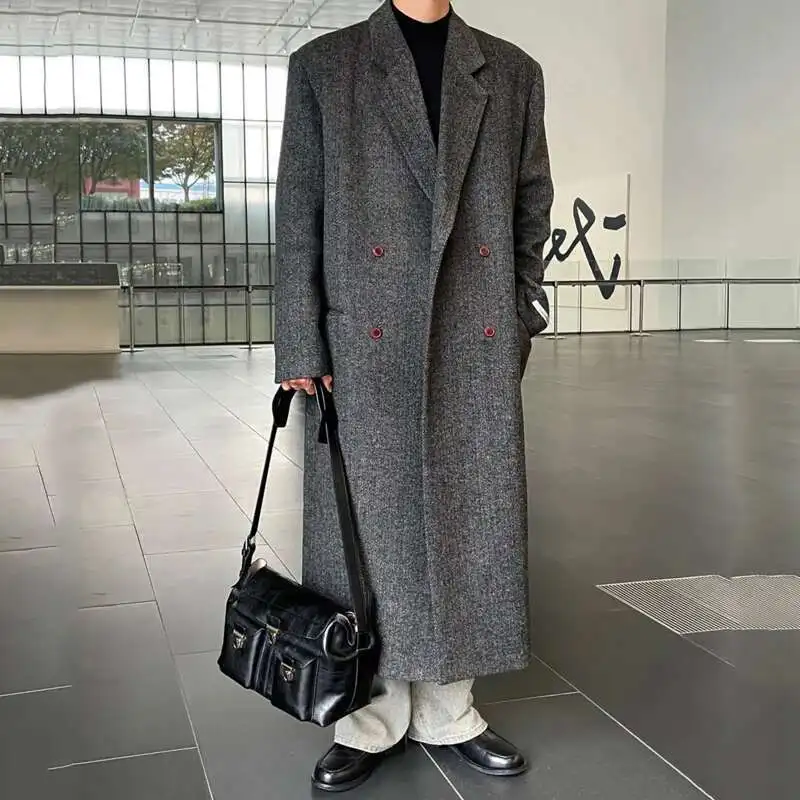
Each style has optimal temperature ranges and occasions. Overcoats provide maximum warmth for winter formal events, while lighter topcoats serve fall and spring functions perfectly. Understanding these distinctions helps you build a versatile formal wardrobe.
Our comprehensive mens overcoats selection offers numerous options to suit various formal requirements.
Key Factors in Choosing Your Formal Dress Coat
Fabric & Material
The fabric of your formal coat significantly impacts its appearance, functionality, and longevity.
Wool Varieties:
– Melton: Dense, smooth surface with excellent wind resistance
– Cashmere: Luxurious softness with superior insulation
– Wool-cashmere blends: Practical compromise between durability and luxury
– Lambswool: Softer than regular wool with natural crimp for warmth
– Camel hair: Distinctive color with excellent insulation properties
Fabric weight matters tremendously. Lighter weights (14-18 oz) work well for moderate climates or indoor-to-outdoor transitions. Heavier weights (20-32 oz) provide substantial warmth for winter formal events.
The material directly affects how formal a coat appears. Smooth, tightly woven fabrics with minimal texture read as more formal than looser weaves or textured surfaces.
Explore our mens wool overcoat collection for premium quality formal options.
Color Selection
Color choice significantly impacts a coat’s formality and versatility:
- Black: Maximum formality, ideal for evening events and black tie
- Charcoal: Extremely versatile, appropriate for nearly all formal occasions
- Navy: Classic formal option that pairs well with most suits
- Camel/Tan: More casual but still acceptable for daytime formal events
- Dark Brown: Limited formal applications, best for daytime
- Patterns: Subtle herringbone or faint pinstripes can work for less formal settings
Evening events generally call for darker colors, while daytime formal occasions permit slightly lighter shades. Always consider what you’ll typically wear underneath – your coat should complement, not clash with, your formal attire.
Fit & Sizing
Proper fit is non-negotiable for formal coats. Key fit considerations include:
- Shoulders: The seam should align with your natural shoulder edge
- Chest: Allow 4-6 inches of room beyond your suit jacket measurement
- Sleeve length: Should extend ½ inch beyond your suit sleeve
- Overall length: Follow mens coat length guide principles based on your height and the coat style
- Collar: Should close comfortably at the neck without gapping
- When trying on: Always wear a suit or similar formal layers underneath
Common fit mistakes include sleeves that are too long, shoulders that extend past your natural shoulder line, and insufficient room to accommodate formal layers underneath.
Construction & Quality Details
Superior construction distinguishes exceptional formal coats:
- Linings: Full silk or high-quality synthetic linings move smoothly over suits
- Buttonholes: Hand-finished buttonholes indicate quality craftsmanship
- Interior structure: Canvas construction provides superior drape
- Seams: Flat, even stitching with no puckering
- Button quality: Horn or high-quality synthetic secured with sturdy thread
- Vents: Clean finishing with proper reinforcement
Quality construction directly affects how the coat drapes on your body, its longevity, and ultimately how polished you appear in formal settings.
Styling Your Dress Coat for Formal Occasions
Coordinating with Different Formal Outfits
The relationship between your formal coat and the outfit beneath requires thoughtful consideration:
For tuxedos, opt for the cleanest lines possible – a black or midnight blue overcoat with minimal detailing creates a harmonious pairing. The coat should frame the formal attire without competing with it.
With business suits, you have more styling flexibility. The formal coat should complement your suit color – navy and charcoal coats pair with virtually any suit, while black works best with darker suits.
When wearing a blazer combination, slightly less formal coat styles like the topcoat or trench can create appropriate balance. The coat should still be more formal than what’s worn underneath.
Essential Accessories
Formal accessories elevate your coat styling:
A formal scarf in silk, cashmere, or fine wool adds both warmth and sophistication. White or cream maximizes formality, while subtle patterns or colors can complement your coat.
Gloves are essential for complete formal presentation – leather in black or dark brown for highest formality, with cashmere lining for comfort.
Traditional hats like the homburg or fedora complete a classic formal look, though they’re optional in contemporary settings.
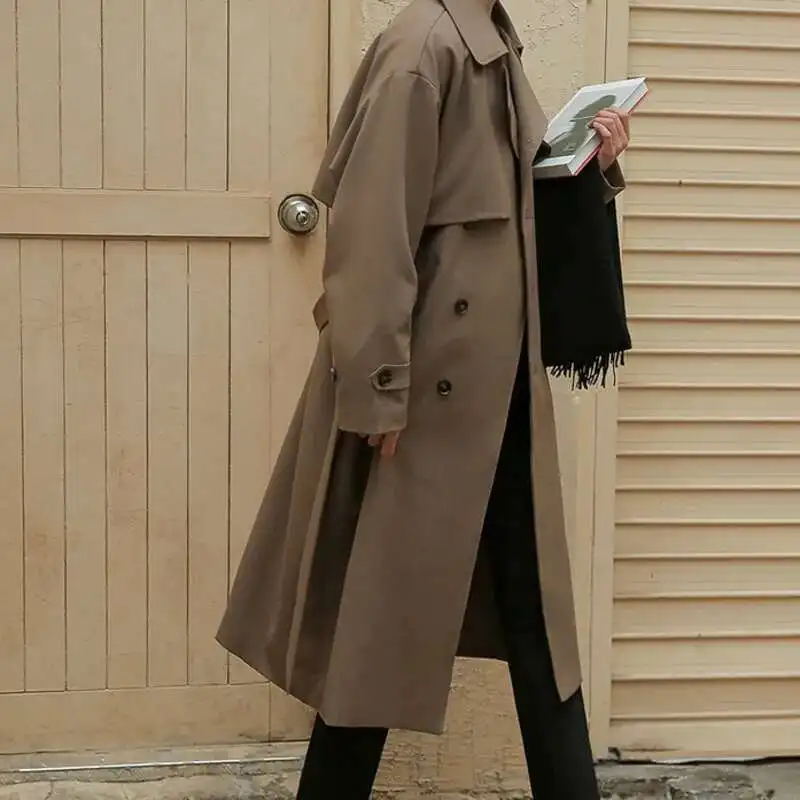
Practical Do’s and Don’ts
Do:
– Button your coat fully when outdoors in formal settings
– Keep the coat on until reaching the coat check at formal events
– Ensure the coat length appropriately covers your formal attire
– Select perfect coat length for height to maintain proper proportions
– Remove gloves when shaking hands
Don’t:
– Stuff pockets with bulky items that distort the coat’s lines
– Leave tags or vent stitching in place
– Wear casual accessories with a formal coat
– Choose overly tight fitting that restricts movement
– Neglect seasonal appropriateness regardless of formality
Occasion-Specific Dress Coat Recommendations
Winter Formal Wedding Guidance
Winter weddings demand both warmth and elegance. For evening ceremonies, a black or charcoal full-length wool overcoat provides appropriate formality. For daytime celebrations, navy or dark gray options work beautifully.
The weight of your coat should correspond to the expected temperatures – heavy wool for truly cold conditions, while lighter weights suffice for mild winter climates. Consider the venue transition as well – outdoor ceremony to indoor reception might require a coat that’s easy to check.
Business Formal Settings
Business formal environments require coats that project authority while maintaining practicality. The Chesterfield and single-breasted topcoat excel in these settings, providing clean lines and professional appearance.
Those seeking detailed essential guide mens dress coats business principles will find that versatility is key for business formal settings. A coat that works across multiple professional environments maximizes your investment.
Black Tie Events
For black tie gatherings, your coat serves as the prelude to your formal ensemble. Traditional black or midnight blue overcoats in wool or cashmere create the appropriate impression. The coat should accommodate the fuller cut of a tuxedo jacket without strain.
Consider subtle formal details like jetted pockets and covered buttons that maintain the clean lines expected for such prestigious occasions.
Cultural Venues (Opera/Theatre)
Traditional cultural venues often call back to more classical formality. Here, time-honored coat styles like the Chesterfield or full-length overcoat demonstrate respect for the setting.
While contemporary styling is acceptable, these venues represent opportunities to embrace the rich history of formal dress. Consider how your coat choice acknowledges the cultural significance of these traditional spaces.
Mens Cashmere Overcoat, Mens Hooded Winter Coat, Mens Wool Blend Coat
Price range: $128.72 through $139.68 Select options This product has multiple variants. The options may be chosen on the product pageMens Black Overcoat, Mens Black Wool Coat, Mens Wool Overcoat
$339.18 Select options This product has multiple variants. The options may be chosen on the product pageMens Grey Overcoat, Mens Wool Blend Coat, Mens Wool Overcoat
$201.28 Select options This product has multiple variants. The options may be chosen on the product pageMens Herringbone Coat, Mens Long Overcoat, Mens Wool Overcoat
Price range: $197.16 through $203.69 Select options This product has multiple variants. The options may be chosen on the product pageMens Long Overcoat, Mens Topcoats
Price range: $189.40 through $196.88 Select options This product has multiple variants. The options may be chosen on the product pageMens Long Overcoat, Mens Tweed Coat
Price range: $397.49 through $409.96 Select options This product has multiple variants. The options may be chosen on the product page
Investing in Quality: Value and Longevity
Price Factors and Quality Differences
Quality formal coats represent significant investments, with prices reflecting several key factors:
Material quality dramatically impacts price – pure cashmere commands premium pricing over wool blends, while higher wool grades (Super 120s and above) offer superior hand feel and drape.
Construction techniques significantly influence both cost and longevity. Hand-stitched elements, full canvas construction, and reinforced stress points require skilled labor but provide superior performance.
Design complexity – including pattern matching, specialized buttonholes, and interior details – adds to production costs but delivers a more refined garment.
Long-Term Value Proposition
When evaluated over time, quality formal coats often represent superior value despite higher initial investment:
A well-constructed wool overcoat can provide 10+ years of service with proper care, dramatically reducing the cost-per-wear compared to lower quality options needing frequent replacement.
Classic formal coat styles remain relevant for decades, avoiding the obsolescence that affects trend-focused outerwear. This styling longevity ensures your investment remains appropriate for formal occasions year after year.
The superior performance of quality coats – better insulation, wind resistance, and water repellency – provides practical benefits beyond mere appearance, further justifying the initial expenditure.
Caring for Your Formal Dress Coat: Ensuring It Lasts
Proper Storage Methods
Appropriate storage dramatically extends your coat’s lifespan:
- Use broad, sturdy wooden hangers that support the shoulders properly
- Allow space between hanging coats to prevent crushing
- Store in breathable garment bags, avoiding plastic that traps moisture
- During off-season, clean thoroughly before storage
- Use cedar blocks or other natural moth deterrents
- Maintain consistent temperature and humidity when possible
- Store away from direct sunlight to prevent fading
Cleaning & Maintenance
Regular maintenance preserves your coat’s appearance and function:
- Brush after each wearing with a proper clothes brush
- Spot clean minor marks promptly using appropriate techniques
- Professional dry clean only when necessary, typically once per season
- Follow material-specific care instructions – cashmere requires different handling than wool
- Allow full drying before storing after exposure to moisture
Browse our mens black overcoat collection for formal options crafted with quality and longevity in mind.
Managing Wrinkles and Shape
Maintaining your coat’s pristine appearance requires attention to its shape:
- Use steaming rather than ironing when possible
- Hang in bathroom during shower to release minor wrinkles
- Allow a day’s rest between wearings when possible
- When traveling, use proper garment bags and fold carefully
- Reshape shoulders and collar after wearing in precipitation
Seasonal Care Steps
Transition between seasons with appropriate care routines:
- End-of-season: Professional cleaning, repair any damage, use proper storage
- Beginning-of-season: Air thoroughly, check for issues, refresh with steaming
- Year-round: Keep away from rough surfaces that can snag fabric
- Address any issues promptly before they worsen
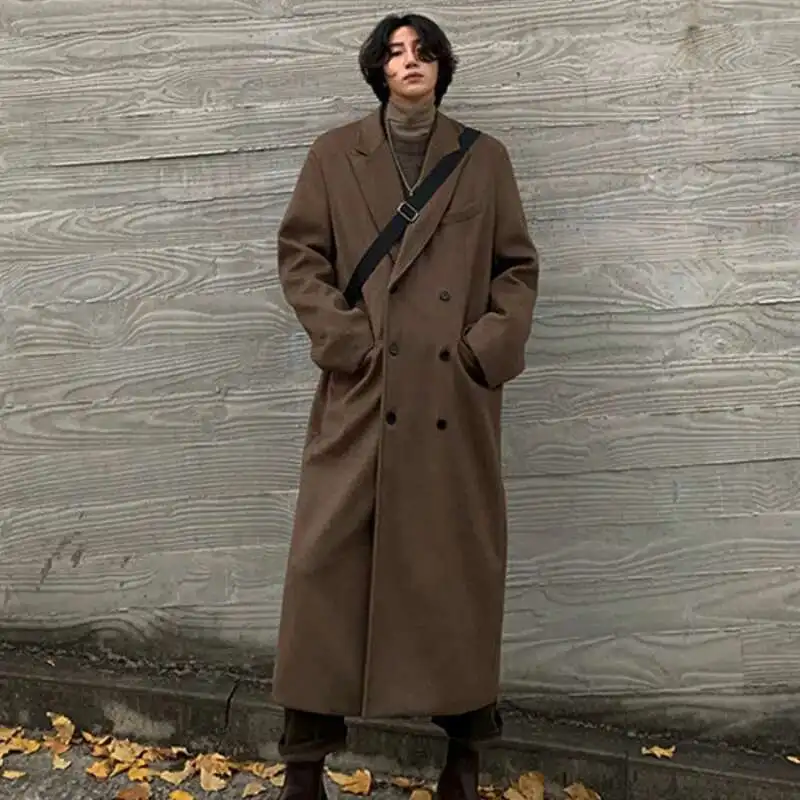
Frequently Asked Questions (FAQs)
What’s the most versatile formal coat color?
Charcoal gray offers maximum versatility across formal occasions, complementing nearly any outfit underneath while working for both day and evening events.
How should the length of my formal coat relate to my height?
Proportional balance matters most. Taller men can wear longer coats gracefully, while shorter men typically benefit from mid-thigh to knee-length options that don’t overwhelm their frame.
Is a trench coat appropriate for black tie events?
While not ideal, a black trench coat can serve for black tie in rainy conditions. However, a wool overcoat remains the preferred choice when weather permits.
What’s the difference between an overcoat and a topcoat?
The primary differences are length and weight. Overcoats typically extend below the knee and use heavier fabrics, while topcoats end mid-thigh to knee and utilize lighter materials.
How can I verify proper fit when purchasing online?
Compare detailed measurements to a well-fitting coat you already own, focusing particularly on shoulder width, chest circumference, and sleeve length. Understanding what mens dress coat called by different retailers helps navigate sizing charts.
How to Find Your Signature Formal Style
While respecting formal dress codes, subtle personalization creates distinction. Consider integrating personal preferences through thoughtful details – perhaps a particular collar style that flatters your face shape, or a specific shade of navy that complements your coloring.
Building a formal coat collection over time allows for occasion-specific options. Starting with a versatile charcoal overcoat provides a foundation, while additional pieces can address specific needs like lighter weights for transitional seasons.
As you develop your formal style, ask yourself:
– Which coat styles make you feel most confident?
– What specific details do you appreciate most?
– How can you balance tradition with personal expression?
– Which formal occasions appear most frequently in your life?
The most successful formal dressing balances respect for convention with confident personal interpretation. Your formal coat should feel like a natural extension of yourself rather than a costume – the hallmark of true style mastery.

